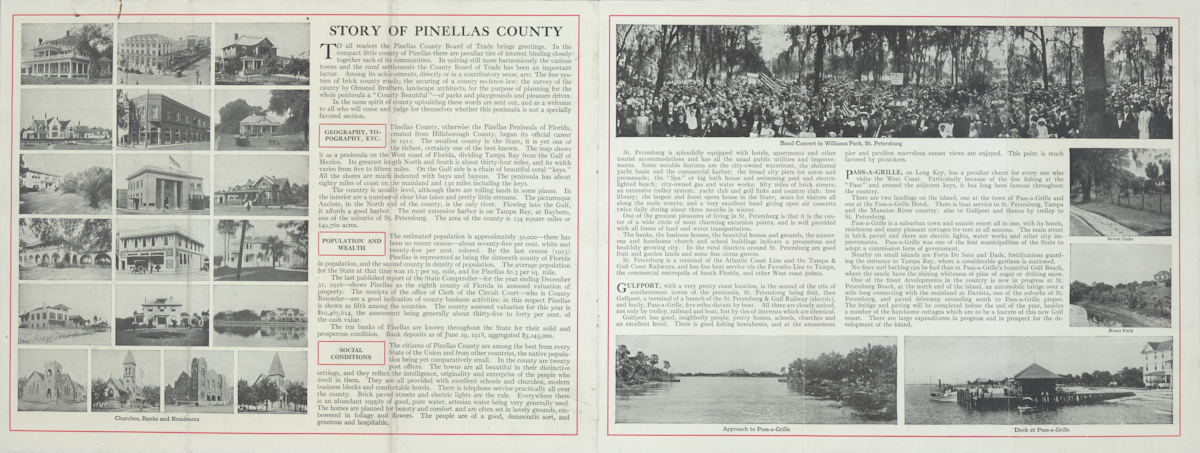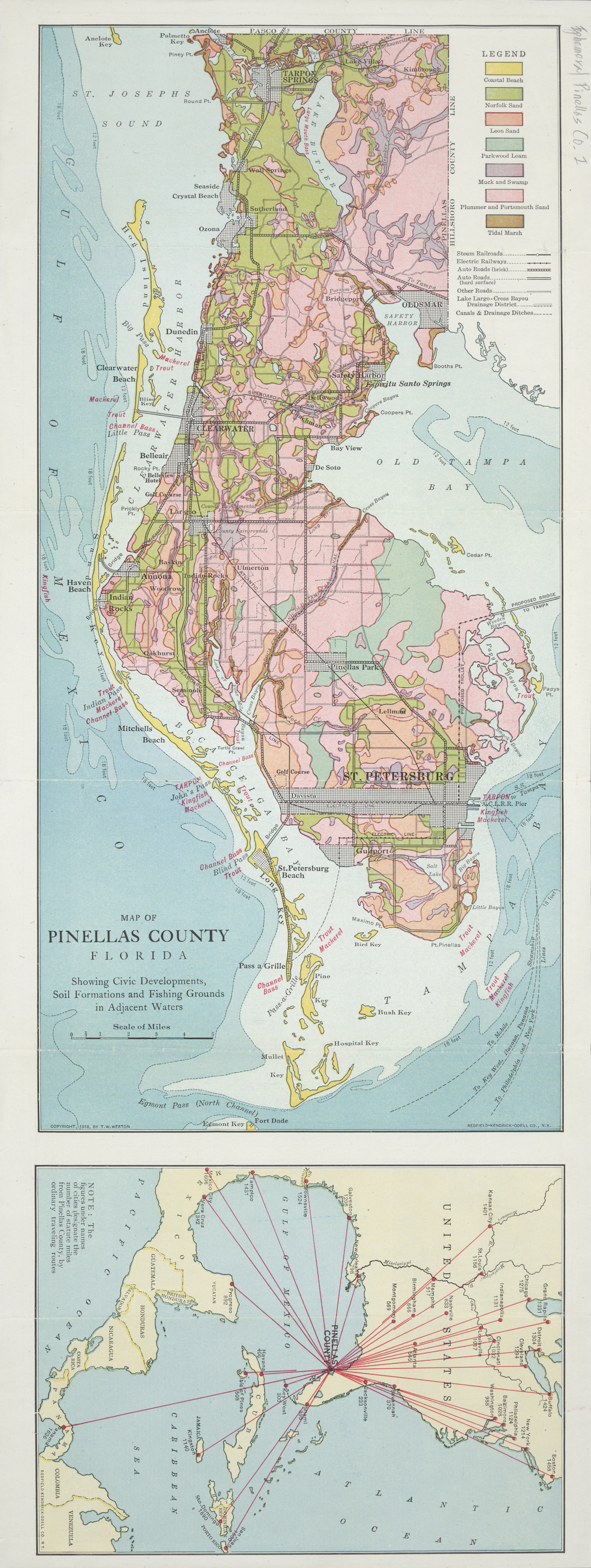Florida Memory is administered by the Florida Department of State, Division of Library and Information Services, Bureau of Archives and Records Management. The digitized records on Florida Memory come from the collections of the State Archives of Florida and the special collections of the State Library of Florida.

State Archives of Florida
- ArchivesFlorida.com
- State Archives Online Catalog
- ArchivesFlorida.com
- ArchivesFlorida.com
State Library of Florida
Related Sites

Description of previous item
Description of next item

Source
Description
Date
Format
Topic
Subjects
Geographic Term
[On the left- 19 photographs of churches, banks, and residential buildings]
Story of Pinellas County
TO all readers the Pinellas County Board of Trade brings greetings. In the compact little county of Pinellas there are peculiar ties of interest binding closely together each of its communities. In uniting still more harmoniously the various towns and the rural settlements the County Board of Trade has been an important factor. Among its achievements, directly or in a contributory sense, are: The fine system of brick county roads; the securing of a county no-fence law; the survey of the county by Olmsted Brothers, landscape architects, for the purpose of planning for the whole peninsula a “County Beautiful””—of parks and playgrounds and pleasure drives. In the same spirit of county upbuilding these words are sent out, and as a welcome to all who will come and judge for themselves whether this peninsula is not a specially favored section.
Geography, Topography, Etc.
Pinellas County, otherwise the Pinellas Peninsula of Florida, created from Hillsborough County, began its official career in 1912. The smallest county in the State, it is yet one of the richest, certainly one of the best known. The map shows it as a peninsula on the West coast of Florida, dividing Tampa Bay from the Gulf of Mexico. Its greatest length North and South is about thirty-four miles, and its width varies from five to fifteen miles. On the Gulf side is a chain of beautiful coral “keys.” All the shores are much indented with bays and bayous. The peninsula has about eighty miles of coast on the mainland and 130 miles including the keys.
The country is usually level, although there are rolling lands in some places. In the interior are a number of clear blue lakes and pretty little streams. The picturesque Anclote, in the North end of the county, is the only river. Flowing into the Gulf, it affords a good harbor. The most extensive harbor is on Tampa Bay, at Bayboro, one of the suburbs of St. Petersburg. The area of the county is 234 square miles or 149,760 acres.
Population and Wealth
The estimated population is approximately 30,000—there has been no recent census—about seventy-five per cent. white and twenty-five per cent. colored. By the last census (1915) Pinellas is represented as being the sixteenth county of Florida in population, and the second county in density of population. The average population for the State at that time was 16.7 per sq. mile, and for Pinellas 80.3 per sq. mile. The last published report of the State Comptroller—for the year ending December 31, 1916—shows Pinellas as the eighth county of Florida in assessed valuation of property. The receipts of the office of Clerk of the Circuit Court—who is County Recorder—are a good indication of county business activities: in this respect Pinellas is shown as fifth among the counties. The county assessed valuation for this year is $10,465,614, the assessment being generally about thirty-five to forty per cent. of the cash value. The ten banks of Pinellas are known throughout the State for their solid and prosperous condition. Bank deposits as of June 29, 1918, aggregated $5,245,000.
Social Conditions
The citizens of Pinellas County are among the best from every State of the Union and from other countries, the native population being yet comparatively small. In the county are twenty post offices. The towns are all beautiful in their distinctive settings, and they reflect the intelligence, originality and enterprise of the people who dwell in them. They are all provided with excellent schools and churches, modern business blocks and comfortable hotels. There is telephone service practically all over the county. Brick paved streets and electric lights are the rule. Everywhere there is an abundant supply of good, pure water, artesian water being very generally used. The homes are planned for beauty and comfort and are often set in lovely grounds, embowered in foliage and flowers. The people are of a good, democratic sort, and generous and hospitable.
[Top of page- photograph of spectators waving flags and holding signs]
Band Concert in Williams Park, St. Augustine
St. Petersburg is splendidly equipped with hotels, apartments and other tourist accommodations and has all the usual public utilities and improvements. Some notable features are the city-owned waterfront, the sheltered yacht basin and the commercial harbor; the broad city piers for autos and promenade; the “Spa” or big bath house and swimming pool and electric lighted beach; city-owned gas and water works; fifty miles of brick streets; an extensive trolley system; yacht club and golf links and country club; free library; the largest and finest opera house in the State; seats for visitors all along the main streets; and a very excellent band giving open air concerts twice daily during about three months in winter.
One of the greatest pleasures of living in St. Petersburg is that it is the center of a wide circle of most charming excursion points, and is well provided with all forms of land and water transportation.
The banks, the business houses, the beautiful homes and grounds, the numerous and handsome church and school buildings indicate a prosperous and healthily growing city. In the rural districts around St. Petersburg are good fruit and garden lands and some fine citrus groves.
St. Petersburg is a terminal of the Atlantic Coast Line and the Tampa & Gulf Coast Railways, and has fine boat service via the Favorite Line to Tampa, the commercial metropolis of South Florida, and other West coast points.
GULFPORT, with a very pretty coast location, is the second of the trio of southernmost towns of the peninsula, St. Petersburg being first, then Gulfport, a terminal of a branch of the St. Petersburg & Gulf Railway (electric), and lastly, Pass-a-Grille, five miles distant by boat. All three are closely united, not only by trolley, railroad and boat, but by ties of interests which are identical. Gulfport has good, neighborly people, pretty homes, schools, churches and an excellent hotel. There is good fishing hereabouts, and at the amusement pier and pavilion marvelous sunset views are enjoyed. This point is much favored by picnickers.
PASS-A-GRILLE, on Long Key, has a peculiar charm for every one who visits the West Coast. Particularly because of the fine fishing at the “Pass” and around the adjacent keys, it has long been famous throughout the country.
There are two landings on the island, one at the town of Pass-a-Grille and one at the Pass-a-Grille Hotel. There is boat service to St. Petersburg, Tampa and the Manatee River country; also to Gulfport and thence by trolley to St. Petersburg.
Pass-a-Grille is a suburban town and seaside resort all in one, with its hotels, residences and many pleasant cottages for rent at all seasons. The main street is brick paved and there are electric lights, water works and other city improvements. Pass-a-Grille was one of the first municipalities of the State to adopt a commission form of government.
Nearby on small islands are Forts De Soto and Dade, fortifications guarding the entrance to Tampa Bay, where a considerable garrison is stationed.
No finer surf bathing can be had than at Pass-a-Grille’s beautiful Gulf Beach, where the sands have the shining whiteness of piles of sugar or drifting snow. One of the finest developments in the country is now in progress at St. Petersburg Beach, at the north end of the island, an automobile bridge over a mile long connecting with the mainland at Davista, one of the suburbs of St.
Petersburg, and paved driveway extending south to Pass-a-Grille proper. The bridge and paving will be completed before the end of the year, besides a number of the handsome cottages which are to be a feature of this new Gulf, resort. There are large expenditures in progress and in prospect for the development of the island.
[Right of page, top- photograph of a home and an oak tree]
Seven Oaks
[Right of page, bottom- photograph of a home and pond]
Roser Park
[Bottom of page, right- photograph of a boat dock]
Dock at Pass-a-Grille
[Bottom of page, left- photograph of a water way lined with palm trees and coastal shrubs]
Approach to Pass-a-Grille
Title
Subject
Description
Creator
Source
Date
Format
Language
Type
Identifier
Coverage
Geographic Term
Thumbnail
ImageID
topic
Subject - Corporate
Transcript
[Color Map. Each type of soil is a different color.]
Map of Pinellas County Florida showing civic developments, soil formations and fishing grounds in adjacent waters
Scale of Miles
Legends
[Yellow] Coastal Beach
[Green] Norfolk Sand
[Orange] Leon Sand
[Aqua] Parkwood Loam
[Purple]- Muck and Swamp
[Pink] Plummer and Portsmouth Band
[Brown] Tidal Marsh
Steam Railroads [line with open circles on stops]
Electric Railway- [Line with closed circles along the line]
Auto Roads (brick)- [two parallel lines with perpendicular lines in between]
Auto Roads (hard surfaces)- [two parallel lines]
Other Roads- [two parallel lines with less space in between than Auto Roads (hard surfaces)]
Lake Largo-Cross Bayou Drainage District- [diagonal lines]
Canals & Drainage Ditches- [dashed line]
[Map of the Eastern U. S. and Central America, with Pinellas County in the middle and straight lines connecting Pinellas County to cities all over the region with distance in miles along usual travel routes to each one.]
[On the left- 19 photographs of churches, banks, and residential buildings]
Story of Pinellas County
TO all readers the Pinellas County Board of Trade brings greetings. In the compact little county of Pinellas there are peculiar ties of interest binding closely together each of its communities. In uniting still more harmoniously the various towns and the rural settlements the County Board of Trade has been an important factor. Among its achievements, directly or in a contributory sense, are: The fine system of brick county roads; the securing of a county no-fence law; the survey of the county by Olmsted Brothers, landscape architects, for the purpose of planning for the whole peninsula a “County Beautiful””—of parks and playgrounds and pleasure drives. In the same spirit of county upbuilding these words are sent out, and as a welcome to all who will come and judge for themselves whether this peninsula is not a specially favored section.
Geography, Topography, Etc.
Pinellas County, otherwise the Pinellas Peninsula of Florida, created from Hillsborough County, began its official career in 1912. The smallest county in the State, it is yet one of the richest, certainly one of the best known. The map shows it as a peninsula on the West coast of Florida, dividing Tampa Bay from the Gulf of Mexico. Its greatest length North and South is about thirty-four miles, and its width varies from five to fifteen miles. On the Gulf side is a chain of beautiful coral “keys.” All the shores are much indented with bays and bayous. The peninsula has about eighty miles of coast on the mainland and 130 miles including the keys.
The country is usually level, although there are rolling lands in some places. In the interior are a number of clear blue lakes and pretty little streams. The picturesque Anclote, in the North end of the county, is the only river. Flowing into the Gulf, it affords a good harbor. The most extensive harbor is on Tampa Bay, at Bayboro, one of the suburbs of St. Petersburg. The area of the county is 234 square miles or 149,760 acres.
Population and Wealth
The estimated population is approximately 30,000—there has been no recent census—about seventy-five per cent. white and twenty-five per cent. colored. By the last census (1915) Pinellas is represented as being the sixteenth county of Florida in population, and the second county in density of population. The average population for the State at that time was 16.7 per sq. mile, and for Pinellas 80.3 per sq. mile. The last published report of the State Comptroller—for the year ending December 31, 1916—shows Pinellas as the eighth county of Florida in assessed valuation of property. The receipts of the office of Clerk of the Circuit Court—who is County Recorder—are a good indication of county business activities: in this respect Pinellas is shown as fifth among the counties. The county assessed valuation for this year is $10,465,614, the assessment being generally about thirty-five to forty per cent. of the cash value. The ten banks of Pinellas are known throughout the State for their solid and prosperous condition. Bank deposits as of June 29, 1918, aggregated $5,245,000.
Social Conditions
The citizens of Pinellas County are among the best from every State of the Union and from other countries, the native population being yet comparatively small. In the county are twenty post offices. The towns are all beautiful in their distinctive settings, and they reflect the intelligence, originality and enterprise of the people who dwell in them. They are all provided with excellent schools and churches, modern business blocks and comfortable hotels. There is telephone service practically all over the county. Brick paved streets and electric lights are the rule. Everywhere there is an abundant supply of good, pure water, artesian water being very generally used. The homes are planned for beauty and comfort and are often set in lovely grounds, embowered in foliage and flowers. The people are of a good, democratic sort, and generous and hospitable.
[Top of page- photograph of spectators waving flags and holding signs]
Band Concert in Williams Park, St. Augustine
St. Petersburg is splendidly equipped with hotels, apartments and other tourist accommodations and has all the usual public utilities and improvements. Some notable features are the city-owned waterfront, the sheltered yacht basin and the commercial harbor; the broad city piers for autos and promenade; the “Spa” or big bath house and swimming pool and electric lighted beach; city-owned gas and water works; fifty miles of brick streets; an extensive trolley system; yacht club and golf links and country club; free library; the largest and finest opera house in the State; seats for visitors all along the main streets; and a very excellent band giving open air concerts twice daily during about three months in winter.
One of the greatest pleasures of living in St. Petersburg is that it is the center of a wide circle of most charming excursion points, and is well provided with all forms of land and water transportation.
The banks, the business houses, the beautiful homes and grounds, the numerous and handsome church and school buildings indicate a prosperous and healthily growing city. In the rural districts around St. Petersburg are good fruit and garden lands and some fine citrus groves.
St. Petersburg is a terminal of the Atlantic Coast Line and the Tampa & Gulf Coast Railways, and has fine boat service via the Favorite Line to Tampa, the commercial metropolis of South Florida, and other West coast points.
GULFPORT, with a very pretty coast location, is the second of the trio of southernmost towns of the peninsula, St. Petersburg being first, then Gulfport, a terminal of a branch of the St. Petersburg & Gulf Railway (electric), and lastly, Pass-a-Grille, five miles distant by boat. All three are closely united, not only by trolley, railroad and boat, but by ties of interests which are identical. Gulfport has good, neighborly people, pretty homes, schools, churches and an excellent hotel. There is good fishing hereabouts, and at the amusement pier and pavilion marvelous sunset views are enjoyed. This point is much favored by picnickers.
PASS-A-GRILLE, on Long Key, has a peculiar charm for every one who visits the West Coast. Particularly because of the fine fishing at the “Pass” and around the adjacent keys, it has long been famous throughout the country.
There are two landings on the island, one at the town of Pass-a-Grille and one at the Pass-a-Grille Hotel. There is boat service to St. Petersburg, Tampa and the Manatee River country; also to Gulfport and thence by trolley to St. Petersburg.
Pass-a-Grille is a suburban town and seaside resort all in one, with its hotels, residences and many pleasant cottages for rent at all seasons. The main street is brick paved and there are electric lights, water works and other city improvements. Pass-a-Grille was one of the first municipalities of the State to adopt a commission form of government.
Nearby on small islands are Forts De Soto and Dade, fortifications guarding the entrance to Tampa Bay, where a considerable garrison is stationed.
No finer surf bathing can be had than at Pass-a-Grille’s beautiful Gulf Beach, where the sands have the shining whiteness of piles of sugar or drifting snow. One of the finest developments in the country is now in progress at St. Petersburg Beach, at the north end of the island, an automobile bridge over a mile long connecting with the mainland at Davista, one of the suburbs of St.
Petersburg, and paved driveway extending south to Pass-a-Grille proper. The bridge and paving will be completed before the end of the year, besides a number of the handsome cottages which are to be a feature of this new Gulf, resort. There are large expenditures in progress and in prospect for the development of the island.
[Right of page, top- photograph of a home and an oak tree]
Seven Oaks
[Right of page, bottom- photograph of a home and pond]
Roser Park
[Bottom of page, right- photograph of a boat dock]
Dock at Pass-a-Grille
[Bottom of page, left- photograph of a water way lined with palm trees and coastal shrubs]
Approach to Pass-a-Grille
Chicago Manual of Style
Pinellas County Board of Trade (Fla.). Map and description of Pinellas County, circa 1919. 1919 (circa). State Archives of Florida, Florida Memory. <https://www.floridamemory.com/items/show/351121>, accessed 23 November 2025.
MLA
Pinellas County Board of Trade (Fla.). Map and description of Pinellas County, circa 1919. 1919 (circa). State Archives of Florida, Florida Memory. Accessed 23 Nov. 2025.<https://www.floridamemory.com/items/show/351121>
AP Style Photo Citation
(State Archives of Florida/Pinellas County Board of Trade (Fla.))

 Listen: The Gospel Program
Listen: The Gospel Program